Related Research Articles

A Manhattan is a cocktail made with whiskey, sweet vermouth, and bitters. While rye is the traditional whiskey of choice, other commonly used whiskies include Canadian whisky, bourbon, blended whiskey, and Tennessee whiskey. The cocktail is usually stirred then strained into a cocktail glass and garnished traditionally with a maraschino cherry. A Manhattan may also be served on the rocks in a lowball glass.

The old fashioned is a cocktail made by muddling sugar with bitters and water, adding whiskey, and garnishing with orange slice or zest and a cocktail cherry. It is traditionally served in an old fashioned glass, which predated the cocktail.
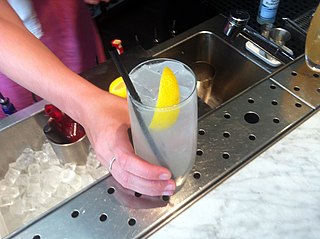
The Tom Collins is a Collins cocktail made from gin, lemon juice, sugar, and carbonated water. First memorialized in writing in 1876 by Jerry Thomas, "the father of American mixology", this "gin and sparkling lemonade" drink is typically served in a Collins glass over ice. A "Collins mix" can be bought premixed at stores and enjoyed alone or with gin.
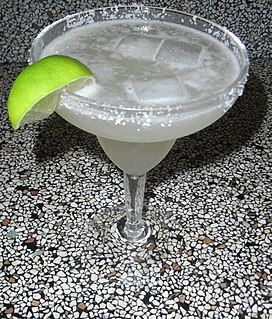
A margarita is a cocktail consisting of tequila, orange liqueur, and lime juice often served with salt on the rim of the glass. The drink is served shaken with ice, blended with ice, or without ice. Although it has become acceptable to serve a margarita in a wide variety of glass types, ranging from cocktail and wine glasses to pint glasses and even large schooners, the drink is traditionally served in the eponymous margarita glass, a stepped-diameter variant of a cocktail glass or champagne coupe.

The Zombie is a Tiki cocktail made of fruit juices, liqueurs, and various rums. It first appeared in late 1934, invented by Donn Beach at his Hollywood Don the Beachcomber restaurant. It was popularized on the East coast soon afterwards at the 1939 New York World's Fair.

The martini is a cocktail made with gin and vermouth, and garnished with an olive or a lemon twist. Over the years, the martini has become one of the best-known mixed alcoholic beverages.
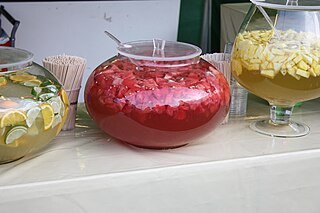
The term punch refers to a wide assortment of drinks, both non-alcoholic and alcoholic, generally containing fruits or fruit juice. The drink was introduced from the Indian subcontinent to England by employees of the East India Company in the late 17th century. Punch is usually served at parties in large, wide bowls, known as punch bowls.

A Stinger is a duo cocktail made by adding crème de menthe to brandy. The cocktail's origins can be traced to the United States in the 1890s, and the beverage remained widely popular in America until the 1970s. It was seen as a drink of the upper class, and has had a somewhat wide cultural impact.
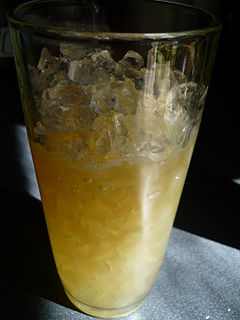
Falernum is either an 11% ABV syrup liqueur or a nonalcoholic syrup from the Caribbean. It is best known for its use in tropical drinks. It contains flavors of ginger, lime, and almond, and frequently cloves or allspice. It may be thought of as a spicier version of orgeat syrup.

A sour is a traditional family of mixed drinks. Sours belong to one of the old families of original cocktails and are described by Jerry Thomas in his 1862 book How to Mix Drinks.
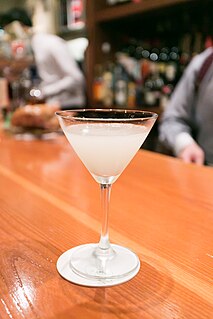
White Lady is a classic cocktail that is made with gin, cointreau or Triple Sec, fresh lemon juice and an optional egg white. It belongs to the sidecar family, made with gin in place of brandy. The cocktail sometimes also includes additional ingredients, for example egg white, sugar, cream, or creme de menthe.

The Fine Art of Mixing Drinks is a book about cocktails by David A. Embury, first published in 1948. The book is noteworthy for its witty, highly opinionated and conversational tone, as well as its categorization of cocktails into two main types: aromatic and sour; its categorization of ingredients into three categories: the base, modifying agents, and special flavorings and coloring agents; and its 1:2:8 ratio for sour type cocktails.
A Rum Swizzle is a rum-based cocktail often called "Bermuda's national drink". The Royal Gazette has referred to it as "the legendary Sam swizzle...perfect for sharing and irresistible to locals and tourists alike". In addition to providing the "swizzle" portion of the 1933 swizzle stick product name, it has been said that this potent cocktail is "as much a part of Bermuda Island culture and cuisine as is the Bermuda onion, the vibrant hibiscus, or the graceful Bermuda Longtail."

A Polar Bear, After Eight or Peppermint Paddy is a mint chocolate cocktail that tastes like a York Peppermint Pattie or an After Eight wafer. It is usually made from crème de cacao and peppermint schnapps, although crème de menthe is a popular substitute.
The fallen angel is a gin cocktail.
The Test Pilot cocktail is a vintage tiki drink invented by Donn Beach. Beach was known for changing his recipes over time, and multiple versions of the Test Pilot attributed to both him and others make the cocktail one of his more frequently imitated and varied tiki drinks. Test Pilot recipes call for multiple rums and typically include the use of falernum syrup and lime juice. The more popular also include Pernod (pastis/absinthe) and bitters.

The Martinez is a classic cocktail that is widely regarded as the direct precursor to the Martini. It serves as the basis for many modern cocktails, and several different versions of the original exist. These are generally distinguished by the accompaniment of either Maraschino or Curacao, as well as differences in gin or bitters.

The Airmail or Air Mail is a classic cocktail based on rum, lime or lemon juice, honey, and sparkling wine. It was probably created during or shortly after the period of prohibition in the United States of America or on Cuba, i.e. in the 1920s or 1930s.
References
- ↑ Delon, Danielle (2016). A Handbook of Trinidad Cookery 1907. Port of Spain: Cassique Publications. p. 154. ISBN 978-976-95415-5-9.
- ↑ Bates, Lindon (1912). Path of the Conquistadores. Boston: Houghton Mifflin Company. p. 72.
- 1 2 3 "Green Swizzle". ArtOfDrink.com. 28 February 2011. Retrieved 2020-08-02.
- ↑ Trinidad Information Bureau: Trinidad: The Riviera of the Caribbean. Trinidad Publishing Company, Port of Spain 1924, p. 44.
- ↑ "History of Angostura Bitters". AngosturaBitters.com. Archived from the original on 17 February 2020. Retrieved 2020-02-17.
- ↑ "Carypton". Mixology.recipes. Retrieved 2021-01-22.
- ↑ Angostura Bitters: Complete Mixing Guide. New York: J.W. Wuppermann. 1912. p. 27.
- ↑ Owen Rutter (1933). If Crab No Walk: A Traveller in the West Indies. London: Hutchinson & Co. p. 48.
- ↑ Lawrence Martin (1958). The Standard Guide to Mexico and the Caribbean. New York: Funk & Wagnalls. p. 650.
- ↑ Sean Muldoon, Jack McGarry, Ben Schaffer (2015). The Dead Rabbit Drinks Manual: Secret Recipes and Barroom Tales from Two Belfast Boys Who Conquered the Cocktail World. Boston: Houghton Mifflin Harcourt. p. 91. ISBN 978-0-544-37339-6.
{{cite book}}: CS1 maint: multiple names: authors list (link) - ↑ "Green Swizzle". Esquire.com. 6 November 2007. Retrieved 2021-09-06.
- ↑ "Green Swizzle". DiffordsGuide.com. Retrieved 2021-10-21.
- ↑ David Wondrich (2015). Imbibe! From Absinthe Cocktail to Whiskey Smash, a Salute in Stories and Drinks to "Professor" Jerry Thomas, Pioneer of the American Bar. London: Penguin. p. 157. ISBN 978-0-698-18185-4.
- ↑ Jeffrey Morgenthaler (2014). The Bar Book: Elements of Cocktail Technique. San Francisco: Chronicle Books. p. 226. ISBN 978-1-4521-1384-5.